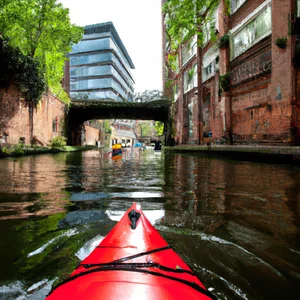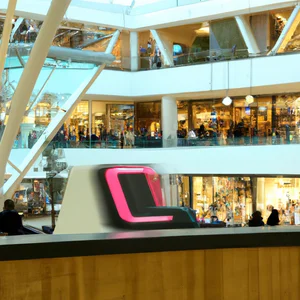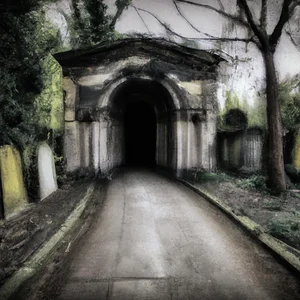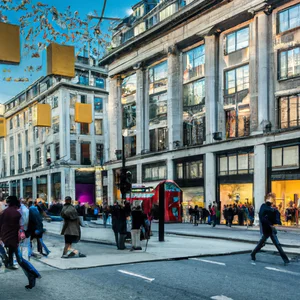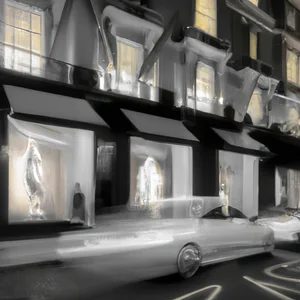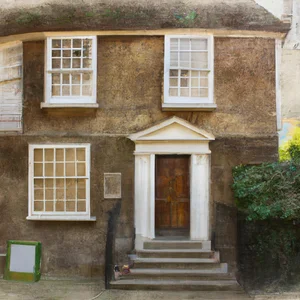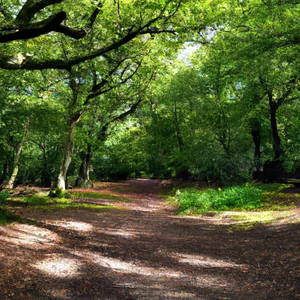Book your experience
Geffrye Museum: Four Centuries of English Domestic Interiors
The Geffrye Museum, guys, it’s a really cool place! If you ever find yourself in London, you absolutely must stop by. Just think, there are four centuries of history of the interiors of English houses, a real journey through time. It’s like stepping into a movie, but without needing a movie ticket!
There, you can see how English homes have changed over the years. From the elegant rooms of the seventeenth century, with their baroque furniture that seems to have come out of a fairy tale, to the more modern styles. It’s a bit like opening a drawer of old family photos and seeing how different we were, right? Each room tells a story, and makes you think about how people lived and related in everyday life.
Once, while wandering through the rooms, I came across a Victorian drawing room. Man, it was so crowded with objects and colors that I felt like I was in a bazaar! I almost had the sensation of hearing the voices of those who lived there, perhaps chatting over a cup of tea. And now that I think about it, it occurred to me that my grandmother had a similar cupboard, full of china.
The thing that struck me most was the idea that every era had its own way of expressing comfort and beauty. I don’t know, but I think it’s fascinating to see how certain trends then come back into vogue, perhaps with some modern tweaks. I mean, style is like an old song, sometimes we dust it off and make it our own, right?
And then, the museum is also in a beautiful garden, where you can take a break and enjoy some greenery. It’s like an oasis in the chaos of London, a nice place to unwind for a moment.
So, if you want to take a dive into the past and discover a bit of history with a touch of style, the Geffrye Museum is the right place. Maybe even bring a good camera, because there are a lot of things to capture!
Discover history through home interiors
A journey through time through the rooms of the Geffrye Museum
When I crossed the threshold of the Geffrye Museum for the first time, I was greeted by the scent of aged wood and an atmosphere of intimacy that only a well-inhabited home can exude. The rooms, each representing a different era, tell stories of English families who, over the centuries, have given life to their domestic spaces. I remember one Victorian room in particular, with its elaborate furniture and velvet detailing, which transported me straight to an afternoon tea of the time. That feeling of being at the heart of a story affected me deeply; the museum is not just a collection of objects, but a living story of the past.
Practical and up-to-date information
Located in the Shoreditch neighbourhood, the Geffrye Museum is easily accessible by tube - get off at Hoxton and a short walk will take you to the entrance. The museum is open Tuesday through Sunday, with extended hours on weekends. Entry is free, although donations are always welcome to support the museum’s activities. It is advisable to check the official website for any special events or temporary exhibitions.
Unconventional advice
If you want to avoid the crowds, I recommend visiting the museum in the late afternoon, just an hour before closing. Not only will you have the chance to explore with greater peace of mind, but you will also be able to enjoy a magical atmosphere as the evening lights begin to filter through the historic windows.
The cultural impact of domestic interiors
The interiors of the Geffrye Museum are not only a celebration of design, but also a reflection on the social and cultural evolutions of England. Each room tells a story of class, economic changes and technological innovations, offering a vivid insight into daily habits over the centuries. Furnishing choices speak to values, aspirations and even the challenges faced by families.
Sustainable tourism practices
The museum is committed to sustainable practices, promoting the use of eco-friendly materials in its displays and encouraging visitors to use public transportation to reach the facility. Furthermore, the museum garden was designed to host native plants, helping to preserve local biodiversity.
An immersive experience
During your visit, don’t miss the opportunity to participate in one of the interactive activities organized by the museum. There are often craft workshops or thematic guided tours that explore specific aspects of English domestic history. These experiences will allow you to put into practice what you have learned and deepen your understanding of the cultural heritage that surrounds us.
Myths to dispel
A common misconception is that history museums, like the Geffrye, are boring and unengaging. In fact, the Geffrye Museum offers a lively and interactive experience, proving that history can be as interesting as life stories itself.
Final reflection
After exploring the rich tapestry of domestic interiors that the Geffrye Museum has to offer, I invite you to reflect: What kind of story does your home tell? Every object, every room has the potential to tell a unique story, just like those that you admired at the museum. Discover your corner of domestic history and be inspired by the beauty of the interiors that surround us.
Explore the rooms: a unique time journey
When I crossed the threshold of a historic English home, the scent of ancient wood and the soft light of the rooms enveloped me like a family hug. The house, a true 18th-century treasure, told stories of past lives through its ornate interiors and architectural details. Each room was a chapter of a novel, and I, a curious reader, was ready to discover the secrets hidden in its corners.
A journey through the ages
In the heart of London, it is possible to embark on a unique time journey by visiting a series of historic houses, such as the Georgian House Museum or the Victorian House. These places offer an immersive experience, allowing visitors to explore rooms that feel like something out of a Jane Austen novel or a Downton Abbey film. Each room is furnished with original furniture, period fabrics and works of art that reflect the fashions and customs of the time.
Insider tip
A little-known tip is to book a visit on weekdays. Not only will you have the opportunity to enjoy a quieter atmosphere, but there are also often small conferences or exclusive guided tours, where industry experts share fascinating anecdotes and details that escape the casual visitor.
The cultural impact
Exploring the domestic interiors of these historic homes is much more than a simple journey into the past; it is an opportunity to understand the evolution of British society. The rooms speak of social stratifications, changes in aesthetic tastes and how daily life was influenced by significant historical events.
Sustainability and responsible tourism
Many of these historic homes are adopting sustainable tourism practices, such as using eco-friendly products to maintain furnishings and promoting events that raise visitor awareness of the importance of preserving cultural heritage. Participating in these initiatives not only enriches your experience, but also helps preserve these wonders for future generations.
An experience not to be missed
While visiting these rooms, don’t forget to take some time in the garden. Often, these green spaces have been thoughtfully designed and offer a haven of tranquility, where you can reflect on the stories you have just discovered. A tea in the garden of a historic home can prove to be a moment of pure magic, combining taste authentic British tradition with the beauty of the surrounding landscape.
Final reflection
Don’t be fooled by the idea that historic homes are just museums; they are real time capsules that invite us to reflect on how past eras continue to influence our contemporary lives. The next time you cross the threshold of one of these houses, ask yourself: what stories do the walls of this room tell?
Curiosities about English design and its evolutions
A journey through time through the rooms of design
I still remember the first time I set foot in a historic English home, the scent of ancient wood and the light that filtered through the sash windows enveloped me in an atmosphere of times gone by. This experience made me understand how deeply English design is rooted in the history and culture of the country. Each room tells a story, from the sumptuous halls of the Victorian eras to the narrow spaces of medieval country houses, revealing the stylistic evolutions and social influences that have characterized centuries of architecture.
The evolution of English design
English design has gone through countless transformations, reflecting the artistic trends and technological innovations of the time. From the understated elegance of Georgian to Baroque Regency, each style carries with it a distinctive imprint. The oak furnishings of sixteenth-century homes evolved into more elaborate and ornate pieces with the use of rich fabrics and bright colors during the Victorian era. Today, contemporary English design is a mix of tradition and innovation, with designers reinterpreting historical elements in a modern way.
Insider tip: look for the “faux fin”
A little-known tip is to pay attention to furniture details, especially finishing techniques. Many antique pieces use the “faux fin” technique, a finish that imitates expensive materials such as ebony or ivory. This not only demonstrates the craftsmanship of the time, but also offers an insight into the society that, in order to save money, looked for ways to beautify their domestic spaces without emptying their pockets.
The cultural impact of design
English design has played a crucial role in shaping the cultural identity of the United Kingdom. The living rooms of aristocratic homes were not only meeting places, but also centers of political and social discussion. The impact of these spaces is still palpable today, influencing not only architecture but also how we live and interact with our environments.
Sustainability and design
Today, many museums and cultural institutions are embracing sustainable tourism practices. In the context of design, this means promoting the use of recycled and sustainable materials, as well as the preservation of traditional craft techniques. For example, the Design Museum in London hosts exhibitions that highlight how design can contribute to a more sustainable future.
Immerse yourself in design
For a first-hand experience, I recommend taking a guided tour of the Design Museum, where you can explore not only the objects on display, but also the creative processes that produced them. It is a unique opportunity to discover the personal stories of designers and understand how English design continues to influence the contemporary world.
Myths to dispel
A common myth is that English design has always been expensive and inaccessible. In reality, many of the most innovative design solutions were born from the need to save money and adapt to small spaces. Country homes, for example, often feature ingenious designs that maximize the use of space without compromising style.
Final reflection
As you explore the world of British design, ask yourself: How does your home environment reflect your personal history and that of your culture? The beauty of design lies not just in its aesthetics, but also in the stories it tells and the emotions it evokes .
A corner of London: gardens and tranquility
A memory among the petals of a rose
I remember the first time I set foot in one of London’s secret gardens. As I walked along a path lined with blooming roses, the scent of lavender and the chirping of birds enveloped me in an embrace of serenity. Even though I was in the beating heart of the capital, that little corner of tranquility seemed like a world apart. That feeling of peace, away from the urban chaos, pushed me to further explore the deep connection between gardens and London culture.
Practical information
London Gardens are not only a haven for local residents, but also a treasure trove of history and beauty. Among the most famous, the Kew Botanic Gardens is a must, but don’t forget to visit the lesser-known gardens such as the Garden of St. Dunstan in the East, an ancient place of worship which today is transformed into an oasis of peace. To reach these gardens, London’s public transport network is impeccable, with tubes and buses taking you there easily. Don’t forget to check the opening hours on VisitLondon.com to better plan your visit.
An insider tip
If you want to have a unique experience, try to visit the gardens early in the morning. The sunlight filtering through the leaves and the silence that envelops the place create an almost magical atmosphere. Additionally, many gardens offer special events, such as outdoor yoga sessions or guided tours that are not widely advertised. Ask local gardeners, they are often willing to share fascinating stories about gardens and the plants that inhabit them.
The cultural impact of gardens
London’s gardens have a rich history dating back centuries, representing an important aspect of the city’s social and cultural life. During the Victorian period, public gardens became places of meeting and recreation, helping to shape community and a sense of belonging. Today, they continue to serve as a refuge for those seeking a break from the frenzy of urban life, enriching local culture with events and celebrations that celebrate nature.
Sustainability and responsible practices
Many London gardens are committing to eco-friendly practices, such as growing native plants and promoting biodiversity. Participating in sustainable gardening workshops or planting events not only connects you with nature, but also supports the local environment.
An invitation to explore
Imagine walking in a hidden garden, surrounded by colorful flowers and centuries-old trees. Take some time to sit on a bench, watch the butterflies fly and reflect on the beauty that surrounds you. One of the lesser-known gardens, Postman’s Park Garden, offers a moving view dedicated to the rescuers who lost their lives trying to save others. It is a place that invites contemplation and connection with London’s history.
Final reflection
London’s gardens are much more than just green spaces; they represent a deep connection with the history and culture of the city. Next time you’re in London, take a moment to explore one of these peaceful corners. We invite you to reflect: what stories could the gardens you visit tell?
Special events: immersive experiences at the museum
An immersion in history
I remember my visit to a local history museum, where I found myself transported to a bygone era thanks to a special event: a Victorian themed night. The actors, dressed in period clothing, recreated scenes from life daily, transforming the museum into a living stage. The air was full of period scents and the sound of a piano resounding in the distance. This experience not only made history vivid, but also sparked in me an unquenchable curiosity about the past.
Practical information
Many museums, especially in London, offer special events ranging from themed evenings, interactive workshops, to talks held by experts in the field. Check the official website of the museum you intend to visit for the latest news. For example, the Museum of London regularly hosts immersive events that allow visitors to interact with history in unique ways. To ensure you don’t miss out on these opportunities, sign up for museum newsletters or follow their social channels.
An insider tip
A tip that few know is to attend events on weekdays. Often, museums offer more intimate, personalized experiences, away from the weekend crowds. Furthermore, evening events can offer a magical and unique atmosphere, with soft lights and an atmosphere of mystery that makes the experience even more fascinating.
Cultural impact
Immersive experiences not only enrich the museum visit, but also have a profound cultural impact. These events bring people closer to history, creating an emotional bond that goes beyond the simple observation of artefacts. Interactive activities help preserve and pass on local culture and traditions, making every visit an opportunity to learn.
Sustainability and responsible tourism
Many museums are becoming increasingly aware of sustainability practices. For example, organizing special events in collaboration with local producers and artisans reduces environmental impact and supports the local economy. Additionally, some of the experiences involve eco-friendly practices, such as using recycled materials for decorations.
The atmosphere of the museum
Imagine walking into a candle-lit museum, with the sound of light footsteps on the wooden floor and the buzz of historical conversations around you. The combination of culture, history and creativity makes these events not only informative, but also deeply engaging.
An experience worth trying
I recommend you take part in a creative writing workshop inspired by the museum’s historical figures. These activities not only stimulate the imagination, but also offer the opportunity to learn fascinating details about the lives of people who shaped history.
Myths to dispel
A common misconception is that museum events are reserved only for academic audiences or history experts. In fact, these experiences are designed to be accessible and fun for everyone, regardless of knowledge level. They are opportunities to have fun and learn in a stimulating environment.
Final reflection
Have you ever thought about how fascinating it can be to experience history rather than just visiting? Next time you plan a trip, consider attending a special event at a museum. You might discover a side of the story you never imagined. And you, which historical period would you like to explore in an immersive event?
Sustainability: how the museum promotes ecological practices
A personal experience
I vividly remember my visit to a museum in London, where, while exploring the historic rooms, I was struck by an astonishing initiative. In one corner of the garden, a group of volunteers were planting native trees and flowers. Their passion for sustainability was contagious and pushed me to reflect on how deep the connection between culture and nature can be.
Practical information
Today, many museums, including the famous Museum of London, are making significant strides in promoting sustainability. The museum has adopted ecological practices such as the recycling of materials and the use of renewable energy to operate the spaces. According to their official website, 70% of the energy used comes from sustainable sources. Additionally, the museum encourages visitors to use public transportation to reach the facility, helping to reduce its environmental impact.
Unconventional advice
When you visit the museum, consider attending one of the eco-gardening workshops that are occasionally held. These events, often led by local experts, offer not only an opportunity to learn sustainable techniques, but also a chance to connect with the community. Many visitors are unaware of these initiatives, so you may find yourself in a small group of enthusiasts.
Cultural and historical impact
Sustainability is not just a trend; it is a necessity that has its roots in the cultural history of London. In recent decades, the city has seen a growing awareness of eco-friendly practices, even influencing museums and galleries. These spaces not only preserve cultural heritage, but are actively committed to preserving the environment for future generations.
Sustainable tourism practices
Many museums, including those in London, are embracing sustainable tourism, encouraging visitors to respect the environment. During your visit, consider bringing a reusable water bottle and avoiding single-use products. Every small gesture counts and contributes to more responsible tourism.
Vivid atmosphere
Imagine walking through the museum garden, surrounded by native plants that attract insects and birds. The air is fresh and the scent of blooming flowers mixes with the delicate sound of leaves blowing in the wind. This is a place where culture and nature blend, creating an atmosphere of peace and reflection.
An experience worth trying
Don’t miss the opportunity to take part in a guided tour dedicated to sustainability. These experiences offer an in-depth look at the museum’s green practices and its efforts to educate the public about the importance of environmental conservation.
Myths and misconceptions
A common misconception about museums is that they are static places, devoid of innovation. In fact, many of them, like the Museum of London, are at the forefront of sustainability, proving that history and innovation can go hand in hand.
Final reflection
As you walk away from this museum, ask yourself: How can I integrate more sustainable practices into my daily life? Your visit is not just a cultural experience, but an opportunity to reflect on how each of us can contribute to a more sustainable future. green.
A unique tip: visit at sunset for less crowds
A personal experience
I remember the first time I visited a museum in London at sunset. The rooms, normally crowded with tourists, were transformed into havens of tranquility. Golden light filtered through the windows, creating plays of shadows that danced on the walls, and each object on display seemed to tell its own story with unexpected intensity. This experience taught me that visiting a museum during the evening hours is not just a strategy to avoid the crowds, but a way to completely immerse yourself in the unique atmosphere of the place.
Practical information
Many London museums, such as the Victoria and Albert Museum and the British Museum, offer weekly evening openings. I recommend checking their official websites for updated hours and any special events scheduled. For example, the V&A is open until 10pm on Fridays, allowing visitors to explore its magnificent collections in a relaxed and almost intimate setting.
Unconventional advice
A secret that few know is that the Most museums offer free admission, but during special evenings there may be a small fee for events or temporary exhibitions. Always check ahead, as some events can sell out quickly. Plus, if you bring a book or notebook with you, you can sit in one of the quiet corners and write down your reflections as the sun sets, making the experience even more personal.
Cultural and historical impact
Visiting museums at sunset offers a new perspective on history and art, allowing you to appreciate the works in a more contemplative atmosphere. This approach also has a positive impact on sustainable tourism, as the reduction of crowds allows for better management of exhibition spaces and greater care for works of art.
Immersive atmosphere
Imagine walking through a gallery, the colors of the artworks glowing under the warm light of the sunset, while the distant sounds of tourists fade into silence. The fresh evening air brings with it a feeling of novelty and discovery, making each visit a unique and memorable experience.
Recommended activity
After exploring the exhibitions, take a break in the museum garden, where you can enjoy a selection of teas and typical sweets. Many museums offer outdoor cafés overlooking green spaces, ideal for reflecting on the works seen and enjoying the sweetness of the evening.
Myths to dispel
A common myth is that museums are always crowded and uninviting. In fact, visiting at sunset can reveal the beauty and serenity of these places, giving the impression of having the entire space to yourself.
Final reflection
Have you ever thought about visiting a museum at sunset? What stories could you discover in such an intimate and evocative atmosphere? Next time you are in London, try planning your visit this way and be surprised by the magic that only the evening hours can offer.
Interviews with curators: stories behind the exhibitions
A personal experience that makes the difference
I vividly remember my first visit to the Geffrye Museum. As I explored the beautifully appointed rooms, I came across a curator who was preparing his presentation for a temporary exhibition. With a contagious passion, he began to tell me fascinating stories about the pieces of furniture on display, revealing anecdotes I would never have imagined. That conversation not only enriched my visit, but profoundly changed my way of seeing home furnishings as a reflection of the life and emotions of those who live there.
Discover the stories behind the objects
Interviews with Geffrye Museum curators offer a unique opportunity to delve into the history of English domestic interiors. These experts, often deeply connected to the objects they care for, are able to transmit their knowledge and passion, revealing links between the furnishings and the social currents of the time. Through their words, it is possible to discover how design has evolved the concept of home and hospitality, transforming private spaces into public reflections of cultural identities.
An insider tip
If you want a truly immersive experience, join one of the “Talks” organized by the museum, where curators discuss specific themes related to the exhibitions. Often, at the end of presentations, there is an opportunity to ask questions and interact directly with these experts, allowing for a deeper connection with the art on display.
The cultural impact of stories
Interior design is not just a matter of aesthetics; it is a powerful storytelling tool. Each piece exhibited at the Geffrye Museum tells a part of the social and cultural history of England, from the bourgeois homes of the Victorian and Edwardian eras to the most modern contemporary spaces. Through interviews with curators, the museum manages to keep this narrative alive, educating the public about the challenges and innovations that have shaped people’s lives over the centuries.
Responsible tourism practices
By encouraging visitors to explore the stories behind the objects, the museum promotes responsible cultural tourism. Investing time to listen and learn from those who keep local history helps preserve the memories and traditions of a community, thus contributing to its cultural sustainability.
Soak up the atmosphere
Imagine getting lost among the wonderful rooms of the museum, each step bringing you closer to a different era, while the curators share stories that awaken your curiosity. The atmosphere is imbued with a sense of discovery, an invitation to reflect on how design choices influence our daily lives.
An experience worth trying
Don’t miss the opportunity to participate in special guided tours led by the curators, where the stories and explanations become an immersive journey through time. You will be able to see the furnishings in a new light as you listen to the narratives that connect them to crucial historical moments.
Myths to dispel
Many mistakenly believe that museums are just spaces for admiring static objects. At the Geffrye Museum, however, every object is a window into a vibrant and ever-evolving world, rich in meaning and history. The true essence of a museum like this is the emotional connection it manages to create between past and present.
Final reflection
The next time you visit the Geffrye Museum, I invite you to consider: What stories can the objects around you in your home tell? Is the house really just a refuge, or is it a stage of experiences, emotions and transformations? Let the museum inspire you to discover the value hidden within the walls of every home.
Discover the local culture: art and crafts in the area
My first visit to the Geffrye Museum was an experience that exceeded my expectations, not only for the charming interior, but also for the vibrant atmosphere surrounding the museum. As I walked through the historic rooms, I noticed that the Hoxton neighborhood, where the museum is located, is a true melting pot of creativity. Local artisans and emerging artists have transformed this area into a hub of innovation and culture, making the museum not only a place of learning, but also a starting point for exploring contemporary art.
Art and craftsmanship: a profound connection
During my visit, I came across a small gallery of local artists just a short walk from the museum. Here, artisans displayed their works, which ranged from hand-painted ceramics to fabrics woven using traditional methods. It’s fascinating to think about how Britain’s cultural heritage still influences design and craftsmanship today. Each piece told a story, just like the museum’s historic interiors. If you have time, don’t miss the opportunity to take a walk in this creative neighborhood and discover the artisan workshops!
An insider tip
If you want to deepen your understanding of local art, try to attend one of the “Open Studios” events held regularly in the neighborhood. This is when artists open their doors to the public, offering a unique opportunity to see their creative process and purchase works directly from them. It’s an intimate and authentic experience that will make you feel part of the artistic community.
Cultural impact and sustainable practices
The Geffrye Museum and local artists share a commitment to sustainability. Many of the workshops and galleries use recycled or eco-friendly materials in their work, reflecting a growing environmental awareness in the community. This approach not only preserves the environment, but also celebrates it tradition of craftsmanship, which often enhances the use of local resources and sustainable techniques.
Soak up the atmosphere
Walking around Hoxton, you can feel the creative energy pervading the air. Colorful murals, small galleries and cozy cafes contribute to a lively and inspiring atmosphere. I recommend taking some time to explore the surrounding streets, perhaps stopping in a café to enjoy a local dessert, while admiring the works of art on display.
Myths to dispel
A common misconception is that contemporary art is inaccessible or expensive. In fact, there are many options for all budgets, and you can often find unique works at reasonable prices. Additionally, many artists are happy to talk about their work and explain their techniques to you, making the experience even more educational and engaging.
In conclusion, Hoxton’s local culture is intrinsically linked to the Geffrye Museum, offering an extraordinary opportunity to explore the evolution of domestic interiors through a contemporary lens. What is the story an object could tell about you?
Authentic taste: coffee and desserts in the museum garden
An experience that enchants the senses
I still remember the moment I discovered the little café hidden in the museum garden. It was a sunny day, and after exploring the historic rooms, the scent of fresh cakes guided me towards a corner of tranquility. Sitting on a wooden bench, surrounded by beautiful flowers and well-tended plants, I enjoyed a freshly baked scone accompanied by a cup of tea. This moment of sweetness, immersed in the beauty of the garden, transformed my visit into an unforgettable experience.
Practical information
The museum café is open every day from 10:00 to 17:00, with an exception on weekends, when hours extend until 18:00. They offer a selection of artisanal desserts and coffee from local roasters, as confirmed by the museum’s official website. Don’t forget to try the carrot cake or their famous lemon cake, which are absolutely delicious.
An insider tip
If you want to avoid long queues and enjoy a moment of tranquility, I recommend visiting the café during the early afternoon hours. Many visitors tend to eat lunch later, so you will find the garden more serene and enjoy uninterrupted views.
A cultural impact
This corner of sweetness is not just a place of refreshment, but a reflection of the local culture. The museum café often hosts gastronomic events, where local chefs present their dishes inspired by the English culinary tradition. This not only supports local artisans, but also creates a link between history and contemporary culture.
Sustainability and responsibility
In an age where responsible tourism is key, the museum café is committed to using organic and local ingredients. Waste disposal practices are carefully maintained, and the garden is an example of sustainable gardening, with native plants that attract local wildlife.
An atmosphere to experience
Imagine sipping a fragrant tea while the birds chirp around you and the sun filters through the foliage. The museum garden is a refuge of serenity, where time seems to stop. Sit back, relax and let your senses be intoxicated with colors and aromas.
Activities to try
In addition to enjoying the desserts, I recommend you take part in one of the cooking workshops that are held periodically in the garden. These experiences will allow you to learn how to prepare traditional English desserts, bringing home a piece of the local gastronomic culture.
Myths to dispel
A common misconception is that museum cafes are expensive and of poor quality. In contrast, the museum café offers great value and dishes prepared with fresh, local ingredients, making the dining experience as memorable as visiting the exhibitions.
A final reflection
After a day full of history and culture, there is nothing better than treating yourself to a moment of sweetness in the museum garden. Which dessert would you like to try and who would you share this experience with?

 Architecture and Design
Architecture and Design Cities and Regions
Cities and Regions Culture and History
Culture and History Events and Festivals
Events and Festivals Fashion and Shopping
Fashion and Shopping Food and Wine
Food and Wine Nature and Adventure
Nature and Adventure Unique Experiences
Unique Experiences


















